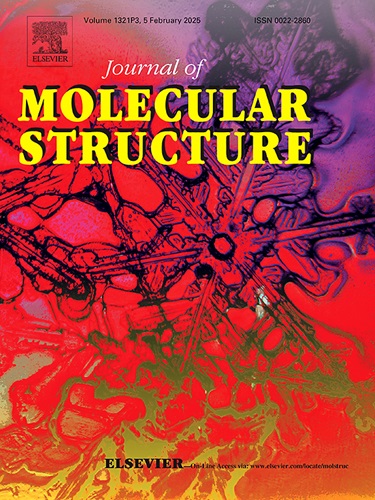N-(3-溴丙基)邻苯二胺的结构表征、计算分析和抗乳腺癌评价
IF 4
2区 化学
Q2 CHEMISTRY, PHYSICAL
引用次数: 0
摘要
在B3LYP/6-311++G(d,p)水平上研究了N-(3-溴丙基)邻苯二甲酸亚胺(BPP)的分子结构和光谱性质。将理论结果与x射线衍射、拉曼光谱和红外光谱的实验数据进行了比较。SEM和EDX分析证实了表面形貌、粒度和元素组成,证实了不存在有害物质。采用基于td - dft的紫外-可见光谱分析方法对气相和溶液(DMSO)的电子性质进行了检测。NBO分析揭示了显著的超共轭相互作用有助于分子稳定性,而MEP表面作图和Mulliken种群分析强调了电子分布和潜在的反应位点。采用GIAO方法计算了理论¹H和¹³C核磁共振化学位移,结果与实验数据吻合较好。Hirshfeld表面和指纹分析提供了对分子内和分子间相互作用的见解。分子对接和药代动力学评价证实了BPP的生物活性潜力。体外筛选MCF-7和MDA-MB-231乳腺癌细胞株,发现对MDA-MB-231有较好的抑制作用。这些发现强调了BPP作为进一步乳腺癌体内研究的候选药物的前景。本文章由计算机程序翻译,如有差异,请以英文原文为准。
Structural Characterization, Computational Analysis, and Anti-Breast Cancer Evaluation of N-(3-Bromopropyl)phthalimide
N-(3-Bromopropyl)phthalimide (BPP) has been investigated at the B3LYP/6-311++G(d,p) level to analyze its molecular structure and spectroscopic properties. The theoretical results were compared with experimental data obtained from X-ray diffraction, Raman, and infrared spectroscopy. SEM and EDX analyses confirmed the surface morphology, particle size, and elemental composition, verifying the absence of hazardous substances. The electronic properties were examined using TD-DFT-based UV-Vis spectral analysis in both the gas and solution (DMSO) phases. NBO analysis revealed significant hyperconjugative interactions that contribute to molecular stability, while MEP surface mapping and Mulliken population analysis highlighted the electronic distribution and potential reactive sites. Theoretical ¹H and ¹³C NMR chemical shifts were calculated using the GIAO method, demonstrating strong agreement with experimental data. Hirshfeld surface and fingerprint analyses provided insights into both intra- and intermolecular interactions. Molecular docking and pharmacokinetic evaluations confirmed the bioactive potential of BPP. In vitro screening against MCF-7 and MDA-MB-231 breast cancer cell lines revealed superior inhibitory activity against MDA-MB-231. These findings underscore BPP’s promise as a candidate for further in vivo breast cancer research.
求助全文
通过发布文献求助,成功后即可免费获取论文全文。
去求助
来源期刊

Journal of Molecular Structure
化学-物理化学
CiteScore
7.10
自引率
15.80%
发文量
2384
审稿时长
45 days
期刊介绍:
The Journal of Molecular Structure is dedicated to the publication of full-length articles and review papers, providing important new structural information on all types of chemical species including:
• Stable and unstable molecules in all types of environments (vapour, molecular beam, liquid, solution, liquid crystal, solid state, matrix-isolated, surface-absorbed etc.)
• Chemical intermediates
• Molecules in excited states
• Biological molecules
• Polymers.
The methods used may include any combination of spectroscopic and non-spectroscopic techniques, for example:
• Infrared spectroscopy (mid, far, near)
• Raman spectroscopy and non-linear Raman methods (CARS, etc.)
• Electronic absorption spectroscopy
• Optical rotatory dispersion and circular dichroism
• Fluorescence and phosphorescence techniques
• Electron spectroscopies (PES, XPS), EXAFS, etc.
• Microwave spectroscopy
• Electron diffraction
• NMR and ESR spectroscopies
• Mössbauer spectroscopy
• X-ray crystallography
• Charge Density Analyses
• Computational Studies (supplementing experimental methods)
We encourage publications combining theoretical and experimental approaches. The structural insights gained by the studies should be correlated with the properties, activity and/ or reactivity of the molecule under investigation and the relevance of this molecule and its implications should be discussed.
 求助内容:
求助内容: 应助结果提醒方式:
应助结果提醒方式:


